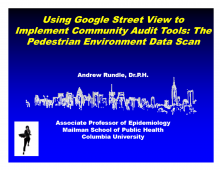We are pleased to announce an exciting new alliance between Active Living Research and GP RED to co-host and coordinate...
Using Google Street View to Implement Community Audit Tools: The Pedestrian Environment Data Scan

Presentation at the Active Living Research Annual Conference
Background:
Numerous community audit tools (CAT) for measuring neighborhood infrastructure supporting walking and physical activity are available through Active Living Research. This approach, which involves sending auditors into neighborhoods to collect data on the presence or absence of physical features, is similar to methods known as Systematic Social Observation (SSO) which were developed in sociology for measuring neighborhood social and physical disorder. The primary disadvantages to using CAT/SSO approaches are the time and expense of data collection, which usually limit their use to small, geographically-circumscribed study areas. Additionally, there can be concerns about the safety of the street auditors requiring auditors to perform the field work in pairs.
As a way to surmount these limitations we propose that the geo-spatial products, Street View and Earth, developed by Google, Inc., can be used as a platform for implementing CAT/SSO protocols. We propose that these technologies can be used to “virtually” send observers to neighborhoods to implement observational audits of neighborhood characteristics. Google Street View and Earth are components of Google Maps (maps.google.com). Street View is a library of images captured by cars driven down the streets of major urban areas in the United States. The images have been processed to allow users to see panoramic street-level views of city streets, pan 360 degrees, rotate the camera vertically 290 degrees, and zoom in and out. Street View allows the user to navigate forward or backward in streets, as if driving. Google Earth is an online resource of hi-resolution aerial images taken by satellite or airplane.
Objectives:
Evaluate whether Google Street View and Earth can be used to implement CAT.
Methods:
In the summer of 2007 we physically audited 76 block faces from 38 street segments in New York City with an inventory of environmental features related to neighborhood walkability, safety and aesthetics. In the summer of 2008 we used Google Street View and Earth to virtually return to these street segments and implemented the same inventory. The goal of this initial trial was to identify items from the inventory that could be viewed via Street View and for which it would be worth developing and testing Street View based measurement protocols. In the summer of 2009 five auditors returned to these street segments both physically and via Street View and implemented the Pedestrian Environment Data Scan (PEDS), a CAT used to measure pedestrian infrastructure.
Results:
Of the 76 block faces visited by the original field team, 74 were available in Street View. The initial viewing of these block faces showed that Street View could be used to collect data on some indicators of physical disorder, on large, static elements of urban design, and on many elements of pedestrian and traffic infrastructure. Street View could not be used to collect data on small items on the sidewalk such as discarded drug paraphernalia, bottles, and cigarette butts, which have been used as markers of disorder in prior studies. Street View was also of little use for identifying age, gender, or social behavior of pedestrians. Google Earth did not prove useful in visualizing audit elements not otherwise visible via Street View. This work suggested that audit tools for measuring neighborhood walkability could be validly implemented via Street View.
Based on this experience, in the summer of 2009 we developed a Street View based implementation of the PEDS. Thus far, five auditors have each implemented the PEDS on the 74 block faces. Cronbach’s alpha scores across raters ranged from 0.21 to 0.96 for the PEDS items. PEDS items with low alpha scores include; the presence of road oriented lighting (0.21), of obstacles that fully impede walking (0.26), of newspaper stands (0.27) and of people standing or walking (0.43). Items with high agreement include, the presence of trees (0.96), of bike route signs (0.95), of bus stops (0.89), of garbage cans (0.88) and of commercial land uses (0.85). Further statistical analyses of inter-rater reliability will be presented at the conference. The physical implementation of the PEDS is ongoing and analyses comparing the PEDS data from the physical and virtual implementation will be presented, as will comparisons of time and salary costs of the two implementations.
Conclusions:
Google Street View appears to be an effective platform for implementing CAT and SSO methodologies to collect data on some neighborhood characteristics. The approach is best for collecting data on large, more temporarily static characteristics of neighborhoods. Street View cannot resolve small items on the sidewalk commonly included in physical disorder SSO tools. Street View is an effective tool for implementing the PEDS measures of neighborhood walkability.
Support:
An ARRA Supplement Providing Summer Research Experiences for Students and Science Educators for NIEHS grant 5R01ES014229.
STAY UP TO DATE
RECENTLY ADDED TOOLS & RESOURCES
MOVE! A BLOG ABOUT ACTIVE LIVING
The "Active Living Conference" aims to break down research and practice silos and...







